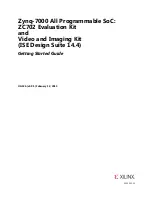Background Debug Module (S12XBDMV2)
S12XS Family Reference Manual, Rev. 1.13
192
Freescale Semiconductor
within a few percent of the actual target speed and the communication protocol can easily tolerate speed
errors of several percent.
As soon as the SYNC request is detected by the target, any partially received command or bit retrieved is
discarded. This is referred to as a soft-reset, equivalent to a time-out in the serial communication. After the
SYNC response, the target will consider the next negative edge (issued by the host) as the start of a new
BDM command or the start of new SYNC request.
Another use of the SYNC command pulse is to abort a pending ACK pulse. The behavior is exactly the
same as in a regular SYNC command. Note that one of the possible causes for a command to not be
acknowledged by the target is a host-target synchronization problem. In this case, the command may not
have been understood by the target and so an ACK response pulse will not be issued.
5.4.10
Instruction Tracing
When a TRACE1 command is issued to the BDM in active BDM, the CPU exits the standard BDM
firmware and executes a single instruction in the user code. Once this has occurred, the CPU is forced to
return to the standard BDM firmware and the BDM is active and ready to receive a new command. If the
TRACE1 command is issued again, the next user instruction will be executed. This facilitates stepping or
tracing through the user code one instruction at a time.
If an interrupt is pending when a TRACE1 command is issued, the interrupt stacking operation occurs but
no user instruction is executed. Once back in standard BDM firmware execution, the program counter
points to the first instruction in the interrupt service routine.
Be aware when tracing through the user code that the execution of the user code is done step by step but
all peripherals are free running. Hence possible timing relations between CPU code execution and
occurrence of events of other peripherals no longer exist.
Do not trace the CPU instruction BGND used for soft breakpoints. Tracing the BGND instruction will
result in a return address pointing to BDM firmware address space.
When tracing through user code which contains stop or wait instructions the following will happen when
the stop or wait instruction is traced:
The CPU enters stop or wait mode and the TRACE1 command can not be finished before leaving the low
power mode. This is the case because BDM active mode can not be entered after CPU executed the stop
instruction. However all BDM hardware commands except the BACKGROUND command are operational
after tracing a stop or wait instruction and still being in stop or wait mode. If system stop mode is entered
(all bus masters are in stop mode) no BDM command is operational.
As soon as stop or wait mode is exited the CPU enters BDM active mode and the saved PC value points to
the entry of the corresponding interrupt service routine.
In case the handshake feature is enabled the corresponding ACK pulse of the TRACE1 command will be
discarded when tracing a stop or wait instruction. Hence there is no ACK pulse when BDM active mode
is entered as part of the TRACE1 command after CPU exited from stop or wait mode. All valid commands
sent during CPU being in stop or wait mode or after CPU exited from stop or wait mode will have an ACK
pulse. The handshake feature becomes disabled only when system stop mode has been reached. Hence
Summary of Contents for MC9S12XS128
Page 4: ...S12XS Family Reference Manual Rev 1 13 4 Freescale Semiconductor ...
Page 168: ...Interrupt S12XINTV2 S12XS Family Reference Manual Rev 1 13 168 Freescale Semiconductor ...
Page 736: ...Ordering Information S12XS Family Reference Manual Rev 1 13 736 Freescale Semiconductor ...
Page 737: ......


















